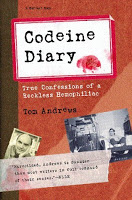
We have so many talented people with hemophilia in our community. One of them is Richard Atwood, currently president of Hemophilia of North Carolina, who shared this wonderful essay below with us. The other was his subject matter, Tom Andrews, who I had the pleasure to know and meet, a long time ago. An award winning poet, Tom lived an adventurous life, “one that was complicated by his hemophilia, and then used those experiences as a way to uniquely express himself in his poetry up to his untimely death,” writes Richard. Tom published several books, perhaps most famous was Codeine Diary, based on his experiences with pain and the narcotic.
Writing wasn’t his only forte: 11-year-old, freckle-faced Tom clapped his hands for 14 hours, 31 minutes to earn a listing in the 1974 edition of the Guinness Book of World Records. As a clumsier and accident prone child, Tom had bruises and bleeds in his knees, ankles, elbows, fingers, and toes. He was diagnosed with factor VIII deficiency when 15 years old. The diagnosis didn’t alter his risk taking behavior of motorcycle riding, skateboarding, and punk rock band playing. 
Here’s his interesting career path: in 1984, Tom graduated from college summa cum laude in philosophy, and then went to work at a 7-11. Tom later worked as a copy editor for the Mathematical Review before teaching writing at the Ohio University and Purdue University. In January 1989, Tom fell on ice in Ann Arbor, MI and broke his right ankle, and began taking codeine for the pain.
Tom was a Poetry Fellow at the American Academy in Rome in 1999. During a visit to Athens, Greece in the summer of 2001, Tom fell ill, and he subsequently died in London, England in July 2001.
Richard writes, “The 1994 collection of autobiographical poems published in The Hemophiliac’s Motorcycle won the 1993 Iowa Poetry Prize. The poet’s first collection of poems published earlier in 1989, The Brother’s Country, was a National Poetry Series winner. Poetry is an unusual medium for an autobiography, though it does allow the beauty of words to be condensed for more meaning, placement, and sound. There were many references to religion and medicine, especially Tom’s female hematologist and the effects of codeine. Italics were used for prayer and other thoughts. The title was taken from one of the poems and indicated the poet’s risk taking behavior.
The 1998 autobiography Codeine Diary was dedicated to John, his older brother. Italics were used extensively for interjected flashbacks and personal thoughts. The author’s life was told in fragmented parts that were often repeated. The autobiography began as a diary of a serious bleed in 1989 and developed into an introspective investigation of the role of hemophilia in his life. Tom did not have any close friends with hemophilia, and he found that each person needs to define what hemophilia means to themselves and to find their own strategies to negotiate hemophilia and to be well. He did acknowledge the benefits of an ideal nurse coordinator and a hematologist.
Thanks so much to Richard Atwood for sharing this with us– may Tom rest in peace, and may we all enjoy his poems. He could well be the most famous poet with hemophilia.
Great Book I Just Read
Hiroshima by John Hersey. This book, which I read just in time to honor the 49th anniversary of the August 6 bombing of Hiroshima and today’s anniversary of the bombing of Nagasaki, is one of those absolutely rare gems: short, full of prose and thoughtfulness, and leaving a lasting impression. The story of the day the A-bomb was first used on civilians, from just before 8:15 am, when the bomb struck, till months afterward, Hershey tells the heart-rending true stories of six survivors—two doctors, two women, and two religious men. You can read this book in one evening, and probably will because it’s hard to put down. Simply told, powerfully effective and unforgettable. A classic. Four stars.

